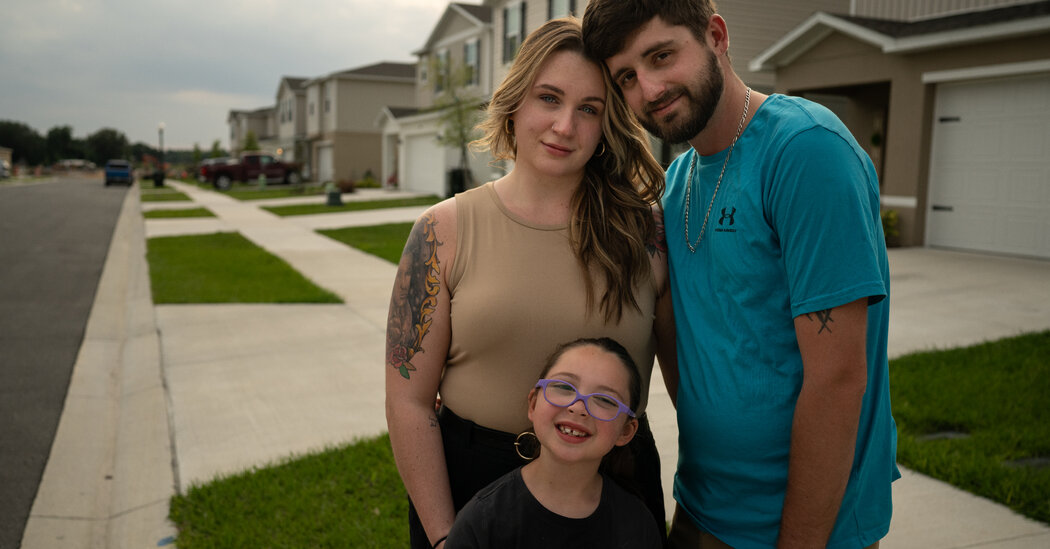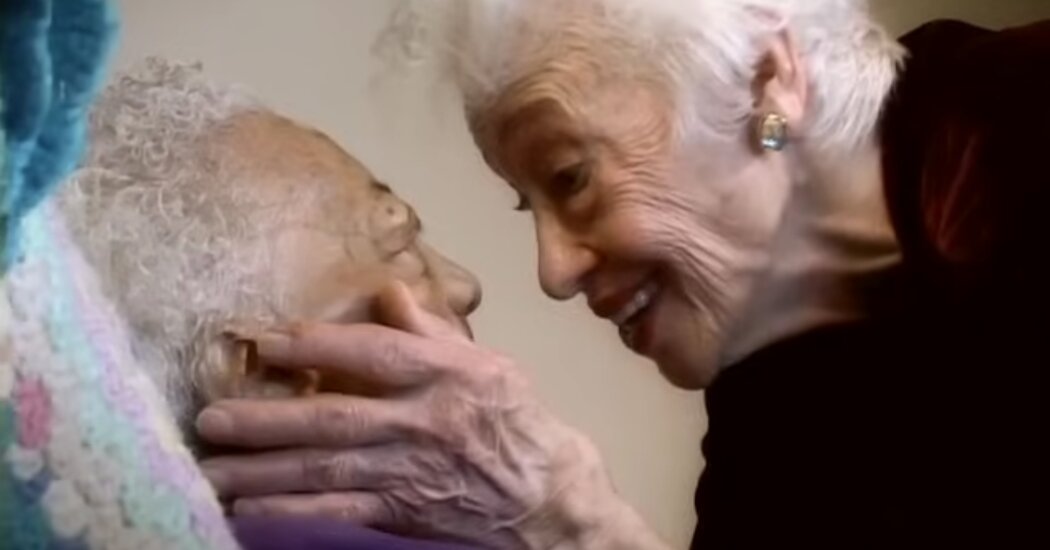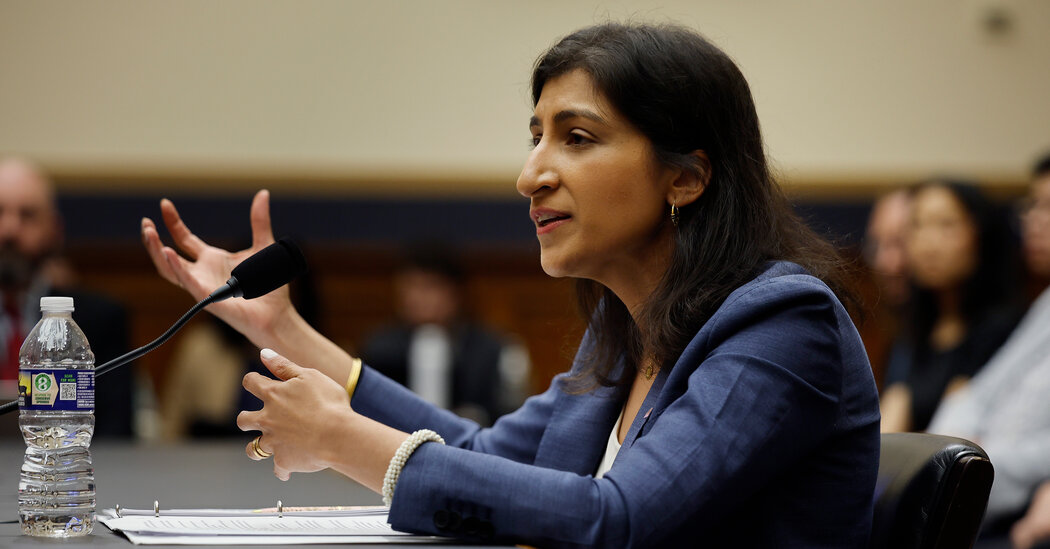Lindsey McNeil and her 7-year-old daughter, Noelle, who suffers from cerebral palsy and epilepsy, were jolted by an alert they received from Florida’s Department of Children and Families late last month that Noelle would be losing her Medicaid coverage 10 days later.
Their lives have since begun to unravel, Ms. McNeil said. Noelle has stopped seeing the four therapists she visits each week and is running low on medications she needs to prevent her seizures from flaring up. Monday brought a measure of relief: Ms. McNeil learned that Noelle’s coverage had been temporarily reinstated as they wait for a resolution to an appeal filed with the state.
“We’ve worked really hard to grow our family and our life and a home for this child,” Ms. McNeil said. “It’s a little daunting to think about what she may lose, and what we may not be able to provide for her.”
Noelle was one of the most recent casualties of the unwinding of a pandemic-era federal policy that required states to keep people on Medicaid, the health insurance program that covers low-income Americans, in exchange for more federal funding. While the policy was in place, enrollees were spared regular eligibility checks. Enrollment in Medicaid and the Children’s Health Insurance Program swelled to a record of more than 90 million, and the nation’s uninsured rate dropped to record lows.
But the policy lapsed at the start of April last year, allowing states to resume trimming their rolls, and the so-called unwinding process that ensued has had far-reaching effects. More than 20 million Americans lost Medicaid at some point in the past year, according to KFF, a nonprofit health policy research group — an unprecedented event in the joint federal-state program’s nearly 60-year history.
The disruption is not over yet. Only about 70 percent of renewal checks have been completed, according to Daniel Tsai, a senior official at the federal Centers for Medicare & Medicaid Services, suggesting that millions more people could lose coverage by the time the process concludes.
Here are some takeaways from the shrinking of Medicaid over the past year.
Many of those who lost coverage have not found an alternative.
In a survey released on Friday by KFF, almost a quarter of adults who lost Medicaid during the unwinding said they were currently uninsured, while 70 percent of those who were dropped from the program said they had wound up uninsured at least temporarily.
The Affordable Care Act’s marketplaces, which recorded a record number of sign-ups for 2024, provided a refuge for some people. Edwin Park, a Georgetown University researcher, pointed to recent federal data that showed that roughly 25 percent of those losing Medicaid had signed up for marketplace plans.
Children have been hit especially hard.
More than half the nation’s children were covered by Medicaid or the Children’s Health Insurance Program before the unwinding began, and the toll on that population has been pronounced.
Nearly five million children have lost Medicaid so far, according to state data analyzed by Georgetown researchers. About two million of them have been in Texas, Georgia and Florida, all of which have not expanded the program under the Affordable Care Act.
Coverage losses have been severely damaging even when temporary. In Richmond, Va., Trina King’s 12-year-old son, Jerome, who has Down syndrome, went about two months without Medicaid late last summer and early fall. Ms. King said the gap was the result of a series of delays in confirming Jerome’s eligibility after she had moved and missed a renewal packet. The mailing had been sent to her old address even though she had notified the state that she had moved, Ms. King said.
Jerome, whose coverage was eventually reinstated, skipped appointments with a roster of specialists who accept Medicaid, including a spine doctor; an ear, nose and throat specialist; a cardiologist; and a urologist, Ms. King said. During the gap in his coverage, his sessions with a home health aide had to be canceled. Ms. King put off a post-surgical follow-up appointment that Jerome needed and also skipped some of his routine medical appointments.
Most people are being dropped because of bureaucratic mistakes.
Like Jerome, roughly 70 percent of people who have lost Medicaid were dropped for what were considered procedural causes, according to a KFF analysis of state data. Many people lost coverage after they did not return required paperwork to a state Medicaid office, while others were accidentally booted because of technical glitches.
Hunter Jolley, a 33-year-old bartender in Little Rock, Ark., who makes around $19,000 a year, lost Medicaid last fall after renewal paperwork was mailed to an old address. Mx. Jolley, who uses the pronouns they and them, said they had failed to secure coverage again despite applying three times to get back into the program.
“It’s all pretty terrifying,” Mx. Jolley said, adding that they had skipped medical and therapy appointments and reduced psychiatry appointments to once every three months, paying $270 out of pocket for them.
Those technical errors stem in part from how Medicaid is organized.
The different ways that state Medicaid programs are set up help explain the varying rates of procedural disenrollments, health policy experts said.
“People often think of one big Medicaid program when we talk about aggregate numbers, but the experience of people across the country, depending on the state they live in, has been very different,” said Mr. Tsai, the federal Medicaid official.
Jennifer Tolbert, a health policy expert at KFF, said the unwinding had laid bare the nation’s highly decentralized system of Medicaid administration, with states using different technology, some of it outdated and glitchy.
Kelly Cantrelle, a senior Medicaid official in Nevada, said the software used by the state to verify eligibility had not been programmed to vet each member of a household correctly, a problem that at one point led to children being booted from Medicaid even if they were still eligible for it. The state’s contractor responsible for the software had to scramble to update it, she added.
Carrying out the enrollment checks has been a complex undertaking even for large state Medicaid bureaucracies. Pennsylvania had roughly 6,000 full-time employees working on the unwinding, said Hoa Pham, an official with the state’s Department of Human Services.
Some argue that trimming enrollment will return Medicaid to its intended scope.
Some health policy experts and state leaders have made the case that paring down the Medicaid rolls over the past year was needed to preserve the program for those eligible for it.
Researchers at the Paragon Health Institute, a conservative policy research organization, estimated last summer that there were about 18 million people on Medicaid who were ineligible for coverage, costing the program more than $80 billion annually.
“Medicaid has eligibility requirements that are on the books,” said Drew Gonshorowski, a researcher at Paragon who has written about the potential savings from trimming the Medicaid rolls. “We shouldn’t be haphazardly expanding coverage by just not doing eligibility determinations. The program should work as intended.”







